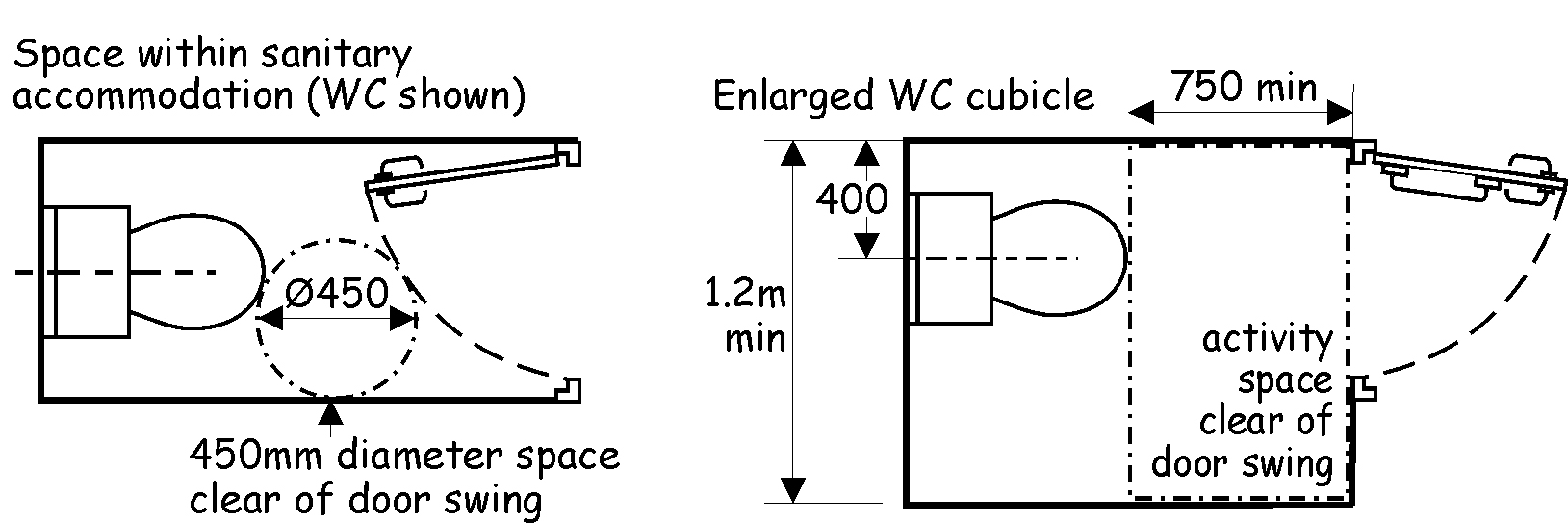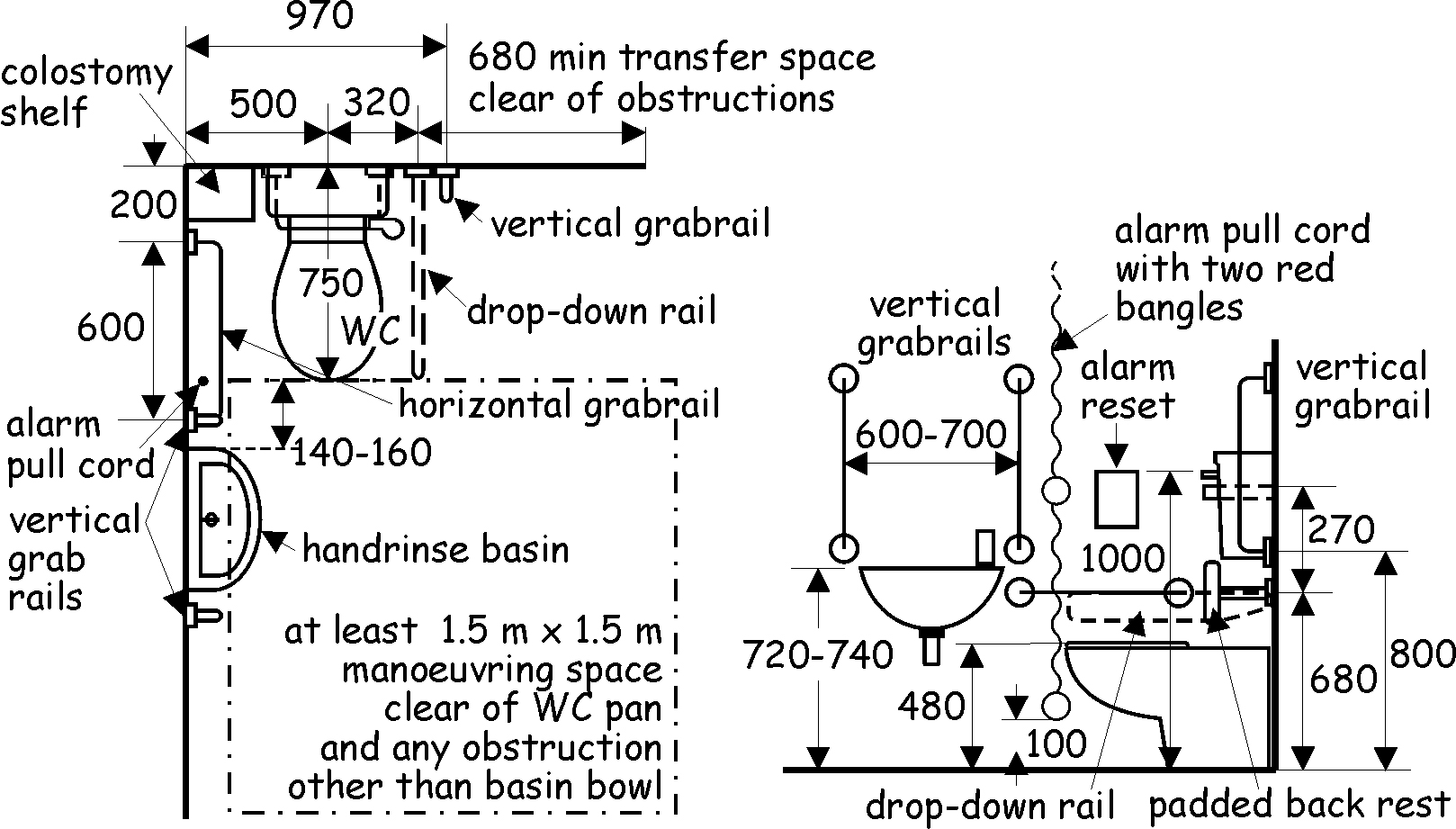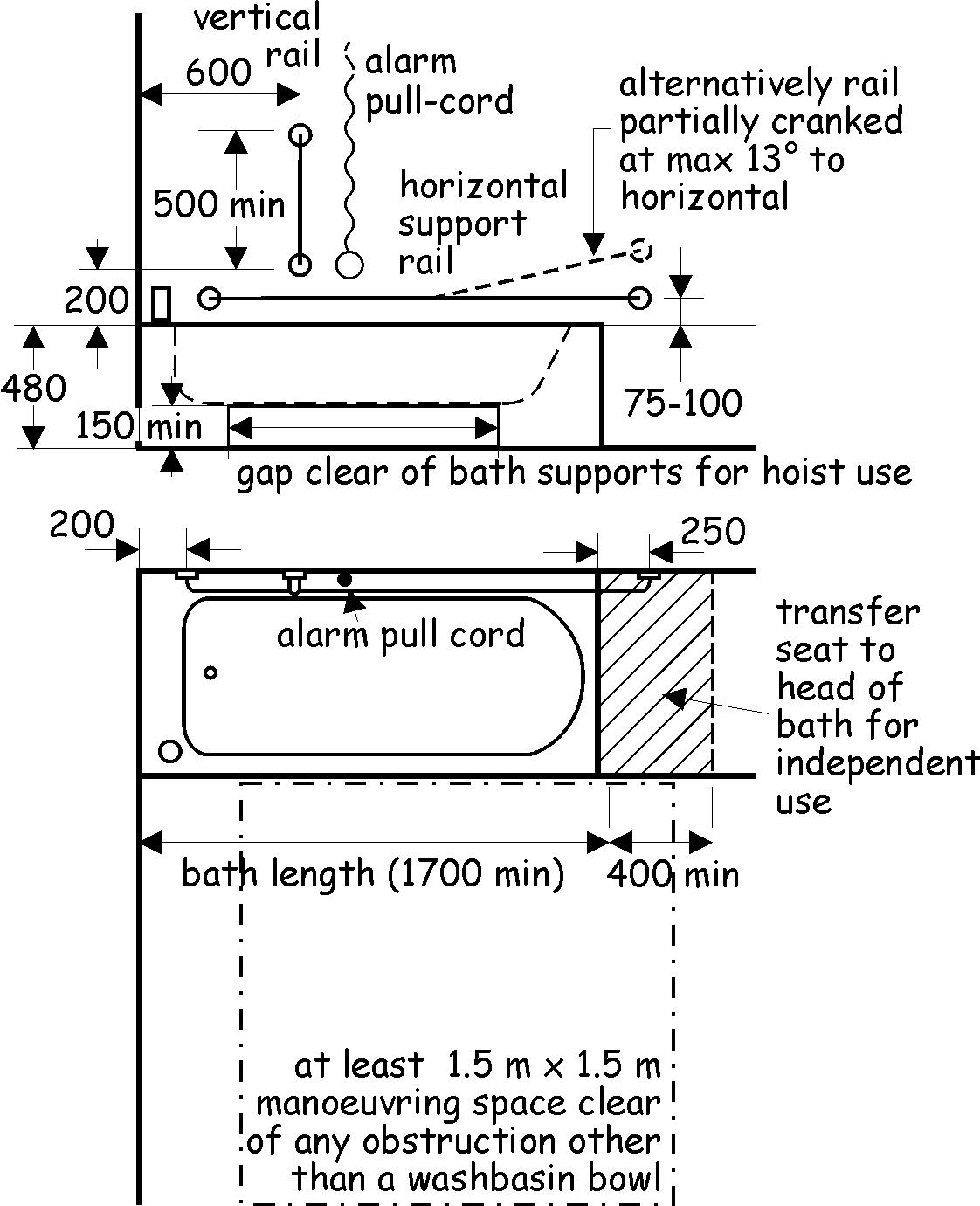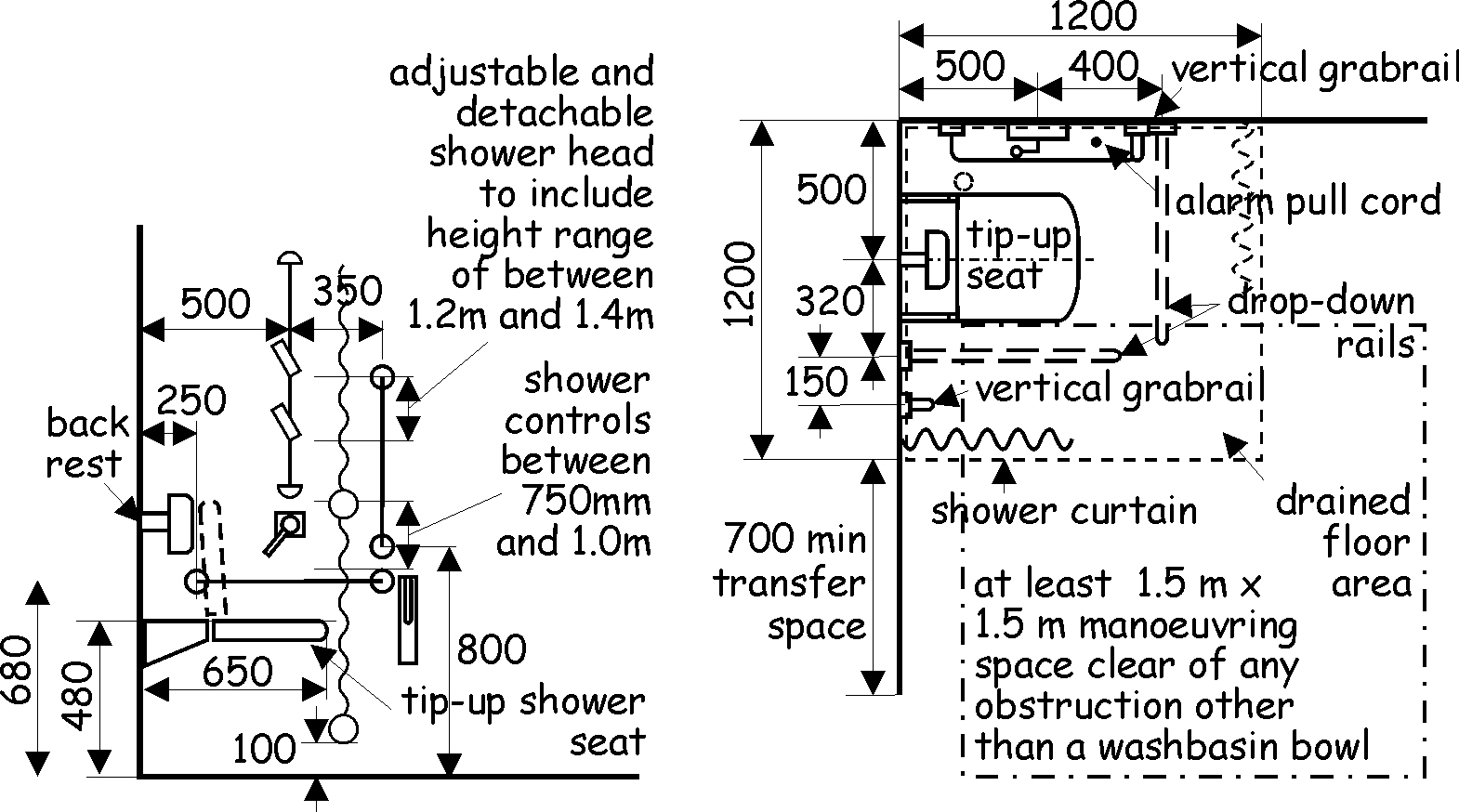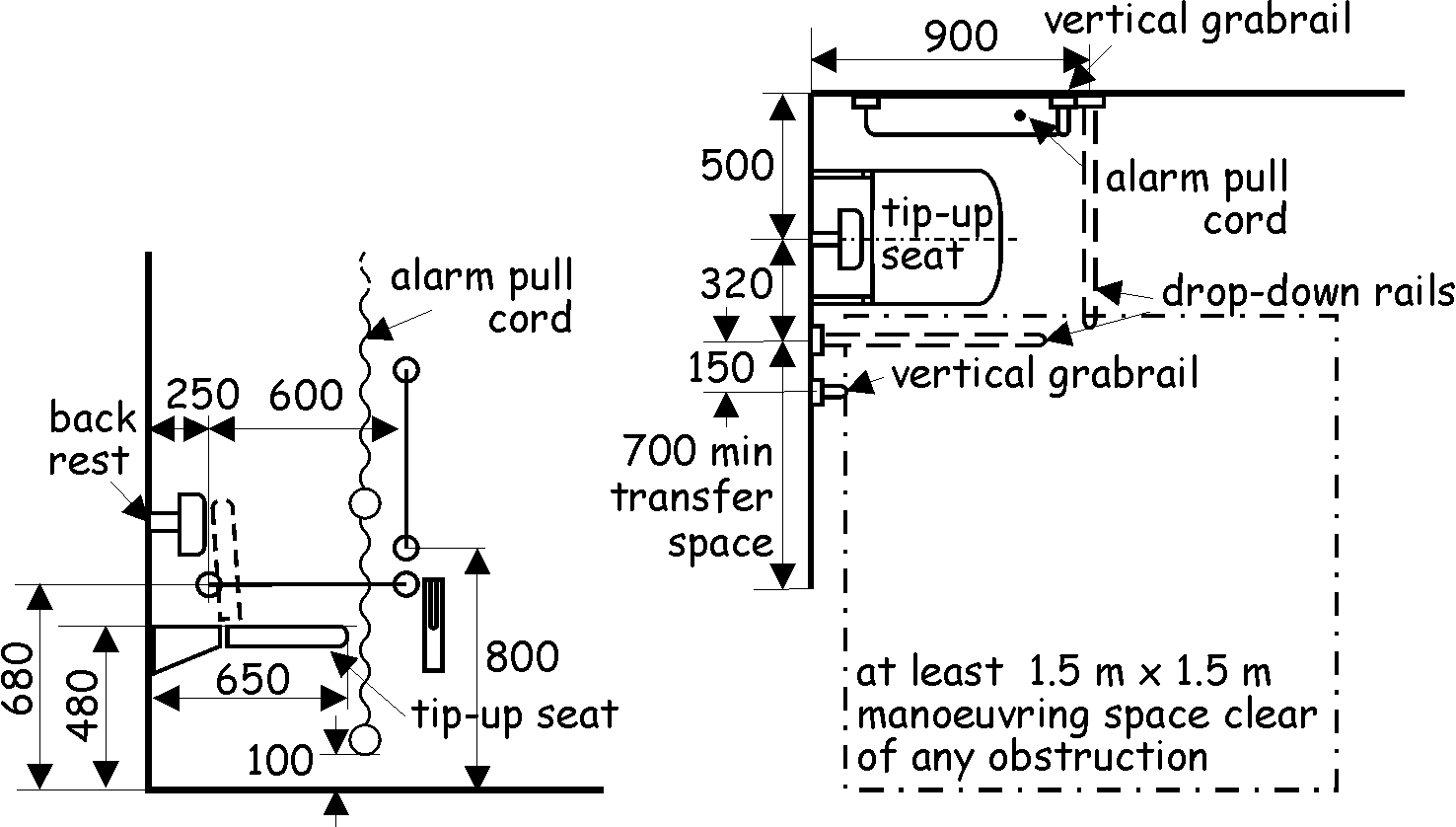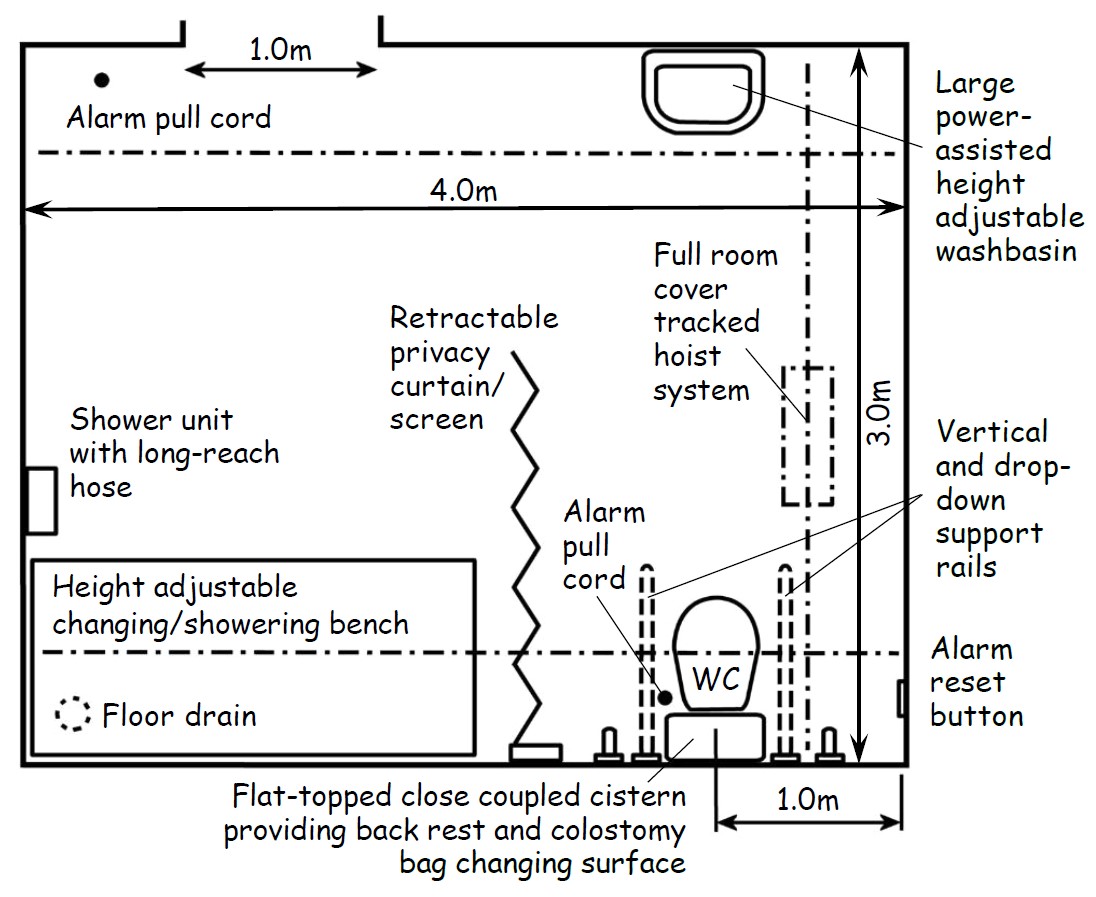3.12 Sanitary facilities
|
It is important that sanitary facilities address the needs of occupants and visitors, both in terms of availability and accessibility. Facilities should be sufficient in number to prevent queuing, other than in exceptional circumstances. Variety in the range and type of facilities provided, particularly in larger buildings, should minimise barriers to the simple and convenient use of sanitary accommodation.
Sanitary accommodation should not be an afterthought in the planning of a building, as this can result in facilities that are small or in awkward locations, making them difficult to access and use. Common issues include screening of the facilities that results in small lobbies and the use of white finishes, sanitary facilities and fittings to suggest cleanliness, creating difficulty for a person with a visual impairment.
Whilst guidance is offered on a variety of building types, some may not be categorised easily. In such cases, designers will need to discuss specific provision with client and user groups and consider the guidance given under this standard to arrive at a practical solution.
The human body absorbs lead easily from drinking water and this can have a negative effect on the intellectual development of young children. Although mains water supplies do not contain significant levels of lead, recent research studies have shown that leaded solder plumbing fittings, normally used for heating systems, have been used on drinking water pipework in contravention of the Scottish Water Byelaws 2004. Further guidance can be obtained from Scotland and Northern Ireland Plumbing Employers Federation (SNIPEF) http://www.snipef.co.uk/ and Scottish Water http://www.scottishwater.co.uk/.
Conversions - in the case of conversions as specified in regulation 4, the building as converted shall meet the requirement of this standard (regulation 12, schedule 6).
The number of sanitary facilities provided within a building should be calculated from the maximum number of persons the building is likely to accommodate at any time, based upon the normal use of the building.
Separate male and female sanitary accommodation is usually provided. This should be based upon the proportion of males and females that will use a building, where this is known, or provide accommodation for equal numbers of each sex otherwise.
Unisex sanitary accommodation may be provided where each sanitary facility, or a WC and wash hand basin, is located within a separate space, for use by only one person at a time, with a door that can be secured from within for privacy.
Small businesses - in small premises, it is recognised that duplication of sanitary facilities may not always be reasonably practicable and that they might be shared between staff and customers. However where practicable, it is good practice for sanitary facilities for staff involved in the preparation or serving of food or drink to be reserved for their sole use, with a separate provision made for customers. Separate hand washing facilities for such staff should always be provided.
Schools - the numbers of sanitary facilities in schools should be provided in accordance with the tables in the School Premises (General Requirements and Standards) (Scotland) Regulations 1967, as amended. The recommendations within BS 6465-1: 2006 may also be helpful. However the School Premises Regulations do not address accessible sanitary facilities which therefore should be provided in accordance with the guidance to this standard.
Specialist buildings - a building providing a service registered or proposing to register under the Regulation of Care (Scotland) Act 2001, such as residential care buildings, day care centres and hospices, may be subject to additional standards set out in the relevant National Care Standards document for that service.
Accessible toilets should be provided within the overall number of sanitary facilities recommended in the various tables in the guidance to this standard, as either:
at least 1 unisex accessible toilet, accessed independently from any other sanitary accommodation, or
where provided within separate sanitary accommodation for males and females, at least 1 accessible toilet for each sex.
The number required will be dependent upon travel distances within a building to an accessible toilet.
A building should be provided with sanitary facilities for staff in accordance with the following table:
Table 3.5. Number of sanitary facilities for staff
| Sex | Staff numbers | WC | WHB | Urinals |
|---|---|---|---|---|
| Male | 1 to 15 | 1 | 1 | 1 |
| 16 to 30 | 2 | 2 | 1 | |
| 31 to 45 | 2 | 2 | 2 | |
| 46 to 60 | 3 | 3 | 2 | |
| 61 to 75 | 3 | 3 | 3 | |
| 76 to 90 | 4 | 4 | 3 | |
| 91 to 100 | 4 | 4 | 4 | |
| over 100 | 1 additional WC, WHB and urinal for every additional 50 males or part thereof | |||
| Female (also male where no urinals provided) | 1 to 5 | 1 | 1 | |
| 6 to 25 | 2 | 2 | ||
| Over 25 | 1 additional WC and WHB for every additional 25 females (or males), or part thereof | |||
Public expectation of facilities in residential buildings has risen considerably over the years and en suite sanitary facilities now tends to be normal practice, though it is recognised that this may not be possible in all cases.
Where sanitary accommodation is not en suite to bedrooms, it should be located directly off a circulation area, close to bedrooms and provided in accordance with the following table:
Table 3.6. Number of sanitary facilities in residential buildings
| Sanitary facility | Number of sanitary facilities |
|---|---|
| WC | 1 per 9 persons, or part thereof |
| WHB | 1 per bedroom [1] |
| Bath or shower | 1 per 4 persons, or part thereof [2] |
Additional information:
For bedrooms, a wash hand basin should be en suite. An alternate ratio of 1 wash hand basin per four persons, or part thereof, may be used for dormitory sleeping accommodation.
Sanitary accommodation containing a bath or shower should also contain a WC and wash hand basin, in addition to the general provision for those sanitary facilities noted in the table.
In a residential building, an accessible bedroom (see clause 4.2.9) should be provided with accessible sanitary accommodation. This should comprise of a WC, wash hand basin and a bath or shower and should be en suite to each accessible bedroom, other than:
when altering or converting an existing building, where it is not reasonably practicable to provide en suite sanitary accommodation, or
where sanitary facilities need to be kept separate for safety reasons, such as in a place of lawful detention.
Where accessible sanitary accommodation is not en suite, it should be located directly off a circulation area, close to any accessible bedroom, and should be clearly identified.
Sanitary accommodation for customers within shops and shopping malls should be clearly identified and located so that it may be easily reached. It should be provided on the entrance storey and, in larger buildings of more than 2 storeys, with a total sales floor area greater than 4,000m2, on every alternate storey. Provision should be as follows:
Table 3.7. Number of sanitary facilities for people, other than staff, in shops
| Building type | Sex | Sales area of shop | Waterclosets | Urinals |
|---|---|---|---|---|
| Shops (Class 1) and shopping malls | unisex | 500m2-1000m2 | 1 | |
| male | 1001m2-2000m2 | 1 | 1 | |
| 2001m2-4000m2 | 1 | 2 | ||
| over 4000m2 | plus 1 WC for each extra 2000m2 of sales area, or part thereof | plus 1 urinal for each extra 2000m2 of sales area, or part thereof | ||
| female | 1000m2-2000m2 | 2 | ||
| 2001m2-4000m2 | 5 | |||
| over 4000m2 | plus 2 WC for each extra 2000m2 of sales area, or part thereof | |||
| Shops (Class 2) and shopping malls | male | 1000m2-4000m2 | 1 | 1 |
| over 4000m2 | plus 1 WC for each extra 3000m2 of sales area, or part thereof | plus 1 urinal for each extra 3000m2 of sales area, or part thereof | ||
| female | 1000m2-2000m2 | 1 | ||
| 2001m2-4000m2 | 3 | |||
| over 4000m2 | plus 1 WC for each extra 3000m2 of sales area, or part thereof | |||
Additional information:
For the purposes of this guidance, shop sales areas are classified as:
C1: (other than those listed under Class 2): supermarkets and department stores (all sales areas); shops for personal services such as hairdressing; shops for the delivery or uplift of goods for cleaning, repair or other treatment or for members of the public themselves carrying out such cleaning, repair or other treatment.
C2: shop sales areas in shops trading predominantly in furniture, floor coverings, cycles, perambulators, large domestic appliances or other bulky goods or trading on a wholesale self-selection basis.
1 wash hand basin should be provided for each WC, plus 1 wash hand basin per 5 urinals, or part thereof.
For shopping malls, the sum of the sales areas of all the shops in the mall should be calculated and used with this table. Sanitary facilities provided within a shop may be included in the overall calculation.
If a shop has a restaurant or cafe, additional sanitary facilities to serve the restaurant should be provided, in accordance with clause 3.12.5.
Provision of sanitary accommodation for customers is not sought in shops below the area limits given above. However below these limits, an accessible toilet provided for staff should be located so that is available for use by customers where this is reasonably practicable.
It is not realistic to include every type of entertainment building and assembly building in the table below. Basic assumptions and reasonable deductions have to be made that best apply to the development under consideration. Provision should be in accordance with the following table:
Table 3.8. Number of sanitary facilities for the public in entertainment and assembly buildings
| Building type [2] | Sex | Number of people | Number of WCs [1] | Number of urinals [1] |
|---|---|---|---|---|
| Buildings used for assembly or entertainment (e.g. places of worship, libraries, cinemas, theatres, concert halls and premises without licensed bars) | male [5] | 1-100 | 1 | 2 |
| 101-250 | 1 | plus 1 for each extra 80 males, or part thereof, over 100 | ||
| over 250 | plus 1 for each extra 500 males, or part thereof | plus 1 for each extra 80 males, or part thereof, over 100 | ||
| female [5] | 1-40 | 3 | ||
| 41-70 | 4 | |||
| 71-100 | 5 | |||
| over 100 | plus 1 for each extra 35 females, or part thereof | |||
| Restaurants, cafés, canteens, fast food outlets (where seating is provided) and takeaway food shops [8] (where seating for more than 6 customers is provided for the consumption of food) | male | 1-10 | See note 6 | |
| 11-400 [7] | 1 for every 100, or part thereof | 1 per 50 males, or part thereof | ||
| over 400 | plus 1 for each extra 250 males, or part thereof | |||
| female | 1-10 | See note 6 | ||
| 11-20 | 2 | |||
| 21-50 | 3 | |||
| 51-100 | 4 | |||
| 101-150 | 5 | |||
| 151-200 | 6 | |||
| over 200 | plus 1 for each extra 100 females, or part thereof | |||
| Public houses and licensed bars [10, 11] | male [9] | 1-75 | 1 | 2 |
| 76-150 | 1 | 3 | ||
| over 150 | plus 1 for each extra 150 males, or part thereof | plus 1 for each extra 75 males, or part thereof | ||
| female [9] | 1-10 | 1 | ||
| 11-25 | 2 | |||
| over 25 | plus 1 for each extra 20 females, or part thereof | |||
| Swimming pools (bathers only) [12] | male | 1-100 | 2 | 1 per 20 males |
| over 100 | plus 1 for each extra 100 males, or part thereof | |||
| female | 1-25 | 2 | ||
| over 25 | plus 1 for each extra 25 females, or part thereof |
Additional information:
1 wash hand basin should be provided for each watercloset, plus 1 wash hand basin per 5 urinals, or part thereof.
In multi-use buildings, each function should be treated separately when calculating overall provision.
Where members of the public are permitted to use sanitary facilities provided for staff, a separate calculation should be made for each group and the total number of sanitary facilities provided accordingly.
There is no requirement to provide sanitary facilities for people other than staff in offices, industrial or storage buildings, but where they are provided, they should be readily accessible to the public, e.g. off the entrance hall or foyer.
In cinema-multiplexes and similar premises where the use of sanitary facilities will be spread through the opening hours, the level of sanitary facilities should normally be based upon 75% of total capacity. For single-screen cinemas, 100% occupancy is assumed.
One unisex WC may be installed for use by both male and female customers for up to and including 20 persons.
In the case of works and office canteens, the scale of provision may be reduced proportionally where there are readily accessible workplace sanitary facilities close to the canteen.
A takeaway food shop is a retail unit that serves hot or cold food, primarily for consumption off the premises, either solely or ancillary to its main use.
Number of customers should be calculated at the rate of 4 persons per 3m2 of effective drinking area (i.e. the total space of those parts of those rooms to which the public has access).
Public houses with restaurants should be provided with sanitary facilities as for licensed bars.
Public houses with public music, singing and dancing licenses should be as for licensed bars. The licensed area for public music, singing and dancing should be separated for calculation of numbers of persons and the provision of sanitary facilities for this area should be in accordance with buildings used for public entertainment.
Sanitary facilities for spectators should be provided in accordance with buildings used for public entertainment.
Provisions made within sanitary accommodation will affect the degree to which the needs of building users are addressed in terms of safety, ease of use and hygiene. To ensure that these issues are addressed, the following provisions should be made within all sanitary accommodation:
sanitary facilities, fittings and surface finishes should be easily cleanable, to allow a hygienic environment to be maintained, and
to allow space for general use, where a door opens into a space containing a sanitary facility, there should be an unobstructed space of at least 450mm in diameter between the sanitary facility and the door swing (see diagram below), and
a door fitted with a privacy lock should have an emergency release, operable from the outside and, if not sliding or opening outward, offer an alternate means of removal, to permit access in an emergency, and
a sanitary facility and any associated aid or fitting, such as a grab rail, should contrast visually with surrounding surfaces to assist in use by a person with a visual impairment.
In addition to the points noted above, every toilet should:
for personal hygiene, have a wash hand basin within either the toilet itself or in an adjacent space providing the sole means of access to the toilet, and
to assist in general hygiene, be separated by a door from any room or space used wholly or partly for the preparation or consumption of food. However this need not be provided to a WC in a place of lawful detention, such as integral sanitary facilities within a prison cell, and
to meet food hygiene regulations, not open directly on to any room or space used wholly or partly for the preparation or consumption of food on a commercial basis. This is most commonly addressed by providing an intervening ventilated space between a toilet and such a space, and
to give variety in provision, including at least one enlarged WC cubicle, as shown below, where sanitary accommodation contains four or more WC cubicles in a range (see diagram above).
In addition, every bathroom or shower room should have a floor surface that minimises the risk of slipping when wet.
Space provision within accessible sanitary accommodation is based primarily upon that needed to accommodate a person in a wheelchair, though this will also offer greater amenity to a wide range of other building users and better allow for assisted use.
Space for manoeuvring and the positioning and relationship of sanitary facilities and assistive aids are the key elements that will allow convenient use of accessible sanitary facilities, with or without assistance and in privacy. At least one sanitary facility of each type provided within a building should be within accessible sanitary accommodation.
Toilets - in addition to the general provisions in clause 3.12.6, accessible sanitary accommodation should:
be clearly identified by signage as accessible sanitary accommodation, and
contain a manoeuvring space of at least 1.5m by 1.5m, clear of any obstruction, including a door swing, other than a wall-mounted wash hand basin which may project not more than 300mm into this space, and
be fitted with fixed and folding grab rails, as shown in the relevant diagram below. Rails should be securely fixed to walls and capable of accommodating the transfer weight of an adult, and
be fitted with an assistance alarm which can be operated or reset when using a sanitary facility and which is also operable from floor level. The alarm should have an audible tone, distinguishable from any fire alarm, together with a visual indicator, both within the sanitary accommodation and outside in a location that will alert building occupants to the call, and
where more than one accessible sanitary facility of a type is provided within a building, offer both left and right hand transfer layouts to allow choice in use by a person who favours a particular transfer method.
Coat hooks, mirrors, toilet paper dispensers and other fixtures that may further assist in use of accessible sanitary accommodation are outwith the remit of the building standards. Advice on provision and location may be found in BS 8300: 2001.
Provision in existing and historic buildings - when altering existing buildings, particularly historical buildings, it may be impractical to provide accessible sanitary accommodation of a size and form equivalent to that described in guidance. In such cases, alternate accommodation that still permits independent use by most wheelchair users, may be considered.
An accessible toilet should be provided in any building with toilet facilities. There should be an accessible toilet at any location where other toilets are provided, unless all occupied parts of the building lie within the travel distance, noted in clause 3.12.9, to another accessible toilet elsewhere in the building.
In addition to the recommendations within clauses 3.12.6 and 3.12.7, an accessible toilet should include a WC with:
a seat height of 480mm, to assist in ease of transfer to and from a wheelchair, and
a flush lever fitted to the transfer side of the cistern.
The time taken to get to an accessible toilet is an important factor to be considered when positioning such sanitary facilities within a building. They should be located where they can be reached easily and the horizontal distance from any part of a building to an accessible toilet should be not more than 45m.
Where there are no toilets on a storey, all occupied parts of that storey should be within 45m of the nearest accessible toilets on an adjacent storey. Any vertical travel by lift need may be discounted but should be limited to one storey.
Where areas within a building are not accessible at certain times, such as where classroom blocks are locked out of hours in a community school, the effect of this on travel distance should taken into account when positioning accessible toilets.
Where people are moving around, such as within the retail area of a large superstore or the concourse of a shopping mall, their distance from an accessible toilet will vary. In such areas, the travel distance may be increased to not more than 100m, provided there are no barriers, such as pass doors or changes of level on the route and the location of the accessible toilet is well signposted. However where people congregate in such areas, such as at a reception desk or at café seating, travel distance should remain not more than 45m.
The availability of accessible sanitary facilities is particularly important within residential buildings or sports facilities, where bathing or showering form an integral part of activities. A person should be able to use such sanitary facilities in privacy, with or without assistance.
In a building where baths or showers are provided, accessible sanitary accommodation should be provided at a ratio of 1 in 20 or part thereof, for each type of sanitary facility provided.
In addition to the recommendations within clauses 3.12.6 and 3.12.7, an accessible shower room or bathroom should:
for a bath, include a transfer space of at least 400mm across the full width of the head of the bath, and
for a shower, have a dished floor of a gradient of not more than 1:50 discharging into a floor drain, or a proprietary level access shower with a drainage area of not less than 1.2m by 1.2m, and
for a shower, have a folding shower seat positioned 500mm from a flanking wall and securely fixed, with a seat height that permits transfer to and from a wheelchair positioned outwith the showering area.
For most people, a level access shower is generally both easier and more convenient to use than a bath and, therefore, should always be included within a building where sanitary facilities for bathing are provided. An accessible shower should be separate or screened from other accommodation, to allow privacy when bathing.
Communal showering areas - in addition, a shower area without separating cubicles, such as found within sporting facilities, which comprises of 10 or more showers should include at least one communal shower with the above provisions.
Separate toilet facilities - to avoid undue waiting times, where an accessible bath or shower is combined with accessible toilet facilities, there should also be a separate accessible toilet provided within the travel distance specified in clause 3.12.9.
As with bathing or showering, the accessibility of changing facilities is particularly important where forming an integral part of activities, such as in sporting facilities, staff changing areas in a place of work or for customers within a clothing shop.
Where individual facilities for changing are provided in a building, at least 1 cubicle in 20, or part thereof, should be of a size and form that will allow use by a wheelchair user, and follow the recommendations within clause 3.12.7. An accessible changing facility should be separate or screened from other accommodation to allow privacy when changing.
Communal changing - in addition, a changing area without separating cubicles, such as found within sporting facilities, to which the public have access and which is intended to accommodate 20 or more people should also include provision for accessible communal changing.
Combine facility - for convenience of use, an accessible changing facility may be combined with an accessible bathing or showering facility to give a combined facility offering privacy in bathing and dressing. In such cases, where a shower is provided, a second fold down seat should be fitted outwith the showering area and manoeuvring space to assist in drying and changing.
Where changing facilities incorporate fixed furniture such as lockers for clothing or personal effects, those assigned to accessible facilities should be positioned within 1.0m of floor level.
In principle, a changing facility for babies should be provided in any building open to the public where such children will usually be present, such as in shops, assembly buildings and entertainment buildings. It is important that such facilities are accessible, both to accommodate a pram or buggy and to permit use by a person with mobility impairment.
Accommodating such a facility within smaller buildings may not be reasonably practicable and, in recognition of this, it need not be provided in all such buildings. However there should be baby changing facilities in:
a shop or shopping mall with a total shop floor area of more than 1000m2, or
an assembly building accommodating more than 200 people, or
an entertainment building, including a restaurant, fast food outlet with seating or a licensed premises, accommodating more than 200 people.
If baby changing facilities are located within a toilet, they will reduce the number of available toilets within a building when in use. Where the toilet in question is also the only accessible toilet, this can cause additional inconvenience.
Baby changing facilities should be provided either as a separate unisex facility or as a dedicated space within both male and female sanitary accommodation and not within an accessible toilet and should contain:
a manoeuvring space of at least 1.5m by 1.5m, clear of any obstruction, including a door swing, other than those noted below, and
a wash hand basin at height of between 720mm and 740mm above floor level. A wall-mounted wash hand basin may project not more than 300mm into the manoeuvring space, and
a changing surface at a height of approximately 750mm, with a clear space of not less than 700mm high beneath. This surface may overlap with a manoeuvring space by not more than 300mm.
A Changing Places Toilet (CPT) provides sanitary facilities suitable for use by people that have more complex care needs and will also assist many other people for whom standard accessible sanitary facilities, for reasons of form or size, are not adequate. Accommodating such a facility within smaller buildings is often not proportionate and in some cases may not be reasonably practicable. In recognition of this, provision of a CPT is sought in larger buildings to which the public have access.
Provision of a CPT should be in addition to, not instead of, the provision of standard and accessible sanitary accommodation. A CPT should be located to provide easy access for users, taking into account factors such as security or payment barriers and the access route to and within the building.
New Construction - a Changing Places Toilet (CPT) should be provided on construction of:
a) A retail building (shop), assembly building or entertainment building, or a building combining any of these uses, which:
is over 5,000 m², or
has a capacity of more than 1,000 persons, or
contains a swimming pool.
b) A hospital, or
c) A secondary school providing community facilities.
Conversion or Extension - where a Changing Places Toilet (CPT) is not already present within a building, one should be provided where a building in any of the above categories is created by conversion or where such a building is extended such that its gross floor area increases by 25% or more.
Layout and facilities - a CPT should provide adequate space to allow a user to be assisted by carers. It should be a minimum of 3m wide by 4m long, with a minimum ceiling height of 2.4m and a door with a minimum clear opening width of 1m. Floor surfaces should have a non-slip finish. The room should include the following sanitary facilities and fixtures:
a peninsular WC
a height adjustable wash hand basin
a ceiling-mounted tracking hoist
a height adjustable adult sized changing bench (minimum length 1.8m)
a retractable privacy screen
grab rails to assist in use of facilities
a call assistance system, and
within a building that includes other changing facilities for users, such as swimming pools/leisure centres, the provision of a wall-mounted shower and floor drainage.
Coat hooks, mirrors, toilet paper dispensers and other fixtures that may further assist in the use of accessible sanitary accommodation are outwith the remit of the building standards. Further information to assist in the planning, layout and delivery of a CPT can be found at the website of the Changing Places Consortium and within BS 8300-2: 2018.
